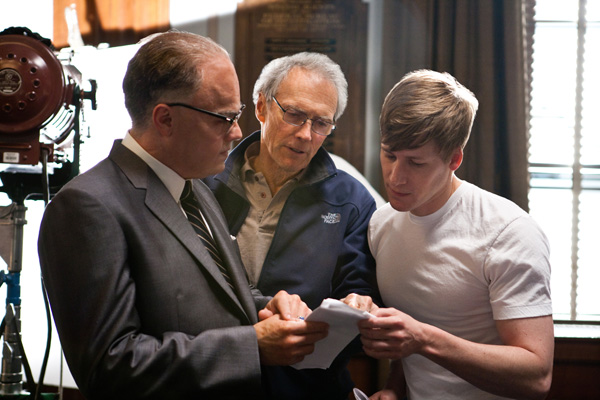 You can read my review of J. Edgar here, but check out this interview by Chris Azzopardi with J. Edgar screenwriter Dustin Lance Black and actor Leonardo DiCaprio:
You can read my review of J. Edgar here, but check out this interview by Chris Azzopardi with J. Edgar screenwriter Dustin Lance Black and actor Leonardo DiCaprio:
No milk for Dustin Lance Black — the 37-year-old filmmaker who says he feels 10 years older today — on this recent morning in a suite at a Beverly Hills hotel. Instead, the screenwriter is nursing a hangover after the premiere J. Edgar, with a bottle of water, joking that “it just means more honest answers; the filter’s down.”
Even without the last drops of Jack and Cokes flushing from his system (proof: lots of bathroom breaks), Black’s always spoke his mind. It’s how the writer has become one of the most admired LGBT activists of our generation, passionately speaking out on hot topics like Prop 8, being a lapsed Mormon and curious dinners with Taylor Lautner (more on that later).
 Today, however, all the talk, or most of it anyway, is around his big Clint Eastwood-directed, Leonardo DiCaprio-carried follow-up to Milk, Black’s biopic about Harvey Milk’s life and legacy that won the writer an Oscar. “It puts a lot of pressure on a lot of your work,” says Black, leaning forward on a sofa. “It’s a dangerous thing to have around the house, so I wrapped him up and flew him to Virginia with my mother. I love him, but he’s not allowed in the house while I’m working. I don’t want to think I’m writing toward that. I want to keep taking risks, and this is a risky film.”
Today, however, all the talk, or most of it anyway, is around his big Clint Eastwood-directed, Leonardo DiCaprio-carried follow-up to Milk, Black’s biopic about Harvey Milk’s life and legacy that won the writer an Oscar. “It puts a lot of pressure on a lot of your work,” says Black, leaning forward on a sofa. “It’s a dangerous thing to have around the house, so I wrapped him up and flew him to Virginia with my mother. I love him, but he’s not allowed in the house while I’m working. I don’t want to think I’m writing toward that. I want to keep taking risks, and this is a risky film.”
It’s risky not just because of the controversial career of its subject, J. Edgar Hoover, the notoriously snaky FBI director who dominated the bureau for nearly 50 years, carrying his tenure through eight presidencies and three wars. What’s attracting the most controversy is the attention the film gives the infamous G-Man’s mysterious private life: Was Hoover’s closest colleague, Clyde Tolson (Armie Hammer of The Social Network), more than just his right-hand man?
“Women were very interested in him and he didn’t respond, but he did like to show up to work every morning with Clyde Tolson and drive home with him each night.” Black laughs. “And this is well before it was fashionable to carpool! So it became incredibly apparent that he wasn’t straight and I started to wonder, ‘Well, what did gay look like? Why was he behaving like that?’”
By interviewing gay men of the time — before Stonewall and the sexual
















Arnold Wayne Jones’ article is extremely provocative on many levels. I will see this movie and discuss it with others because of concepts and ideas in the article. The art of film making can provide knowledge and understanding of recent history and culture, and help me understand the present and make wiser, personal decisions.